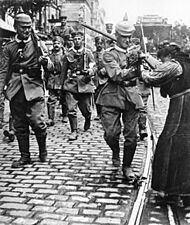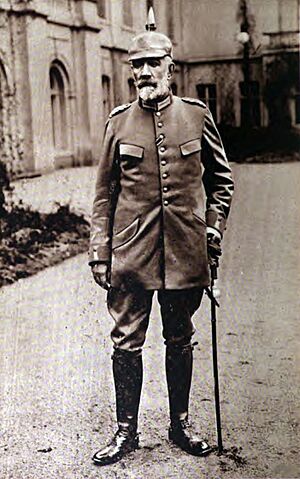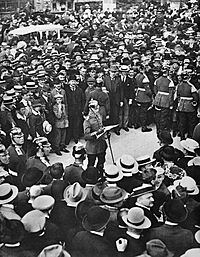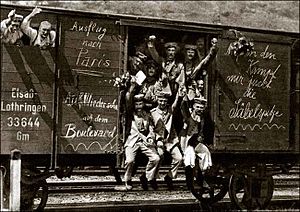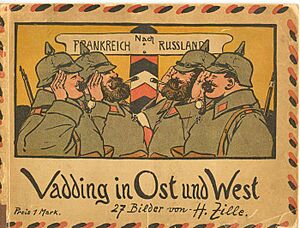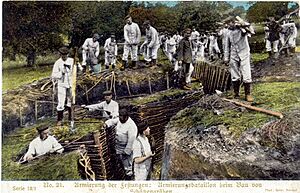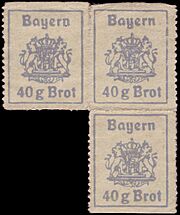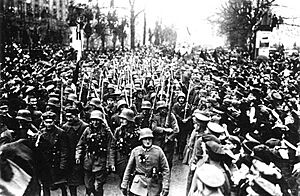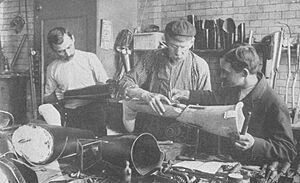History of Germany during World War I facts for kids
During World War I, the German Empire was one of the Central Powers. Germany joined the fight after its friend, Austria-Hungary, declared war on Serbia. German soldiers fought the Allies on both the eastern and western sides. Most of Germany itself was safe from invasion during the war. However, in 1914, East Prussia was briefly invaded.
The Royal Navy set up a tight blockade, which meant very little food could get into German cities. This caused severe food shortages, especially in the winter of 1916–17, which was called the Turnip Winter. When the war ended, Germany was defeated. Many people were unhappy, which led to the German Revolution of 1918–1919. This revolution removed the monarchy (the Kaiser and royal families) and created the Weimar Republic, a new government.
Contents
Germany Enters World War I
When the war started in 1914, people in Germany had mixed feelings. Some felt great excitement and unity for the war, known as the "Spirit of 1914." However, not everyone felt this way.
The German government, led by powerful landowners called Junkers, saw the war as a way to stop being surrounded by countries they saw as enemies: France, Russia, and Britain. They told the public that the war was a chance for Germany to gain its "place under the sun," meaning to become a more powerful nation. Many people supported this idea due to strong nationalism.
The government also hoped the war would unite the public behind the Kaiser (the emperor). It aimed to lessen the threat from the growing Social Democratic Party of Germany, which had criticized the Kaiser before the war. Despite its international beliefs, the Social Democratic Party supported Germany's war effort.
Germany spent a huge amount of money, 170 billion Marks, on the war. This money came from banks and from people buying war bonds. These bonds became worthless later because of extreme inflation in 1923.
It soon became clear that Germany was not ready for a long war. The economy was not well organized for wartime. Germany relied on importing food and raw materials, but the British blockade stopped these imports. First, food prices were controlled, then rationing began. In 1915, five million pigs were killed to save grain for people. The winter of 1916–17 was called the "Turnip Winter" because potatoes were scarce, and people had to eat turnips, usually animal food. From 1914 to 1919, about 474,000 German civilians died because of poor nutrition, exhaustion, and disease.
German Government Leaders
Theobald von Bethmann Hollweg was Germany's Chancellor (like a prime minister) at the start of the war. In July 1914, he worried about Russia's growing power and the close ties between Britain and France. He decided to support Austria-Hungary in a small war against Serbia, hoping it wouldn't lead to a bigger war with Russia. He thought France would not help Russia.
However, his plan failed when Russia started to prepare its army. Germany's own army then demanded to use the Schlieffen Plan. This plan was designed for a quick victory against France by attacking through neutral Belgium. By invading Belgium, Germany brought Britain into the war. Bethmann Hollweg failed to keep France and Britain out of the conflict.
The crisis became very serious on July 5, 1914. Bethmann Hollweg was told that Britain would not get involved. This made Austria-Hungary more confident to demand things from Serbia. He warned Russia that their actions would force Germany to prepare its army, and then a European war would be almost impossible to stop.
After Archduke Franz Ferdinand was killed in Sarajevo on June 28, 1914, Bethmann Hollweg and his foreign minister, Gottlieb von Jagow, promised Germany's full support to Austria-Hungary. This was regardless of Austria's actions against Serbia. When Britain suggested mediation, Bethmann Hollweg wanted Austria-Hungary to attack Serbia. He even changed a message from Britain to make it seem like Britain wouldn't interfere.
When the Kaiser returned to Berlin, he was very angry with Bethmann Hollweg.
When Wilhelm arrived at the Potsdam station late in the evening of July 26, he was met by a pale, agitated, and somewhat fearful Chancellor. Bethmann Hollweg's apprehension stemmed not from the dangers of the looming war, but rather from his fear of the Kaiser's wrath when the extent of his deceptions were revealed. The Kaiser's first words to him were suitably brusque: "How did it all happen?" Rather than attempt to explain, the Chancellor offered his resignation by way of apology. Wilhelm refused to accept it, muttering furiously, "You've made this stew, now you're going to eat it!"
Bethmann Hollweg had tried to have good relations with Britain before the war. He was very upset when Britain declared war after Germany invaded Belgium. He reportedly asked the British Ambassador, Edward Goschen, how Britain could go to war over a "scrap of paper" ("ein Fetzen Papier"). This "scrap of paper" was the 1839 Treaty of London, which guaranteed Belgium's neutrality.
As the war continued, military leaders like Paul von Hindenburg and Erich Ludendorff gained more power. They often made decisions that went against Bethmann Hollweg's wishes. For example, they pushed for unrestricted submarine warfare in March 1917, even though Bethmann Hollweg was against it. This led to the United States entering the war in April 1917.
Bethmann Hollweg stayed in office until July 1917. He resigned after a group of parties in the Reichstag (German parliament) passed a "Peace Resolution." Also, strong military leaders like Hindenburg and Ludendorff threatened to resign if he stayed. This pressure forced Bethmann Hollweg to step down.
Early War Years (1914–1915)
The German army started the war on the Western Front with a plan called the Schlieffen Plan. The idea was to quickly attack France by going through neutral Belgium. Then, they would turn south to surround the French army. The Belgians fought back and damaged their own railway system to slow the Germans down. The Germans were surprised by this and responded by harming civilians, killing almost 6,000 non-combatants and burning many homes.
At first, the Germans were very successful, especially in the Battle of the Frontiers (August 14–24). But by September 12, the French, with help from British forces, stopped the German advance east of Paris at the First Battle of the Marne (September 5–12). This battle marked the end of fast-moving warfare in the west. Both sides then dug long lines of trenches.
In the east, only one German army defended East Prussia. When Russia attacked this area, Germany had to send soldiers there who were originally meant for the Western Front. Germany defeated Russia in battles known as the First Battle of Tannenberg (August 17 – September 2). But sending troops to the east meant Germany could not win a quick victory. Germany was forced to fight a war on two fronts, which was much harder.
The Year 1916
The year 1916 saw two huge battles on the Western Front: at Verdun and the Somme. Both battles lasted most of the year, gained very little land, and caused massive losses of soldiers on both sides. Verdun became a symbol of how deadly modern weapons were. Germany lost 280,000 soldiers, and France lost 315,000. At the Somme, Germany had over 400,000 casualties, while the Allies had over 600,000.
At Verdun, the Germans attacked a French area they thought was weak. But the French defended it fiercely because of national pride. The Somme was part of a plan by the Allies to attack on different fronts at the same time. Germany also faced problems from Russia's large "Brusilov offensive" in the east, which forced them to send more soldiers and resources there.
Many experts believe the Battle of the Somme was a British victory. They say it was the point where German morale (their fighting spirit) started to drop for good. Germany lost many experienced soldiers and confidence.
The Year 1917
By early 1917, the enthusiasm for the war was fading in Germany. There were huge numbers of casualties, fewer men available to fight, and growing problems at home. The constant news of deaths made people feel grimmer.
The Social Democratic Party (SPD) split in 1917. Its anti-war members were kicked out and formed a new group called the Independent Social Democratic Party of Germany. The remaining part was called the Majority Social Democratic Party of Germany.
Later in 1917, German morale improved because of victories against Serbia, Greece, Italy, and Russia. These wins helped the Central Powers gain ground. Morale was at its highest since 1914 at the end of 1917 and beginning of 1918. This was especially true after Russia left the war due to its own revolution. The German people prepared for what General Erich Ludendorff said would be the "Peace Offensive" in the west.
The Final Year (1918)
In spring 1918, Germany knew time was running out. They prepared for a final, decisive attack on the Western Front. They hoped to win the war before millions of American soldiers arrived. General Erich Ludendorff and Field Marshal Paul von Hindenburg were in charge of the army. They moved many soldiers from the Eastern Front and trained special "storm troopers" with new tactics. These storm troopers would race through enemy trenches and attack command centers.
These new tactics did make the Western Front more mobile again. During the winter of 1917-18, the Western Front was "quiet." The Germans secretly brought in their best soldiers from the east and trained them in the new tactics. German artillery would fire a sudden, strong barrage just before their infantry attacked. Small groups of storm troopers, firing light machine guns, would go around enemy strongpoints and head straight for important bridges, command posts, and artillery. These shock troops often scared the first line of defenders, who would run away. These tactics brought back movement to the battlefield, but they didn't increase Germany's firepower enough.
Ludendorff made a mistake by attacking the British first in 1918, instead of the French. He thought the British would not react quickly to the new tactics. The German attacks on the British were very strong. At the Somme River in March, 63 German divisions attacked in a thick fog. The British lost 270,000 men and fell back 40 miles, but then they held their ground. They quickly learned how to deal with the new German tactics: fall back, leave the trenches, let the attackers spread out too much, and then counterattack. They had an advantage with their artillery and tanks.
In April, Ludendorff attacked the British again, causing 305,000 casualties. But he didn't have enough reserve soldiers to keep pushing. Ludendorff launched five big attacks between March and July, causing a million British and French casualties. The Western Front was now open, but the Allies held on. The Germans lost twice as many soldiers as they caused the Allies to lose, including most of their valuable storm troopers. The new German soldiers were either too young, or older men who were tired and in poor health. They were not excited about the war and some even started talking about revolution. Ludendorff could not replace his losses or find a new way to win. The British were also bringing in soldiers from their whole Empire, and their morale was higher because they could see victory coming. The big German spring offensive was a race against time, as everyone knew millions of fresh American soldiers would soon arrive.

The long, tiring war had worn down both sides. Germany had used up its best soldiers and still hadn't conquered much land. The British were also bringing in young men and older, less fit men, but they saw the Americans arriving steadily. The French had also almost run out of men. Berlin had thought it would take months for the Americans to send all their soldiers and equipment. But U.S. troops arrived much faster because they left their heavy equipment behind and used British and French artillery, tanks, and trucks. Berlin also thought Americans were not tough enough for hard fighting. They soon realized they were wrong. German reports said that American soldiers were "remarkable" and "physically well set up." They only needed more training and experience to become "formidable adversaries."
By September 1918, the Central Powers were exhausted. American forces were arriving in France at a rate of 10,000 a day. The British Empire had 4.5 million soldiers and 4,000 tanks on the Western Front. The Allies' strong counterattack, called the Hundred Days Offensive, began on August 8, 1918. Ludendorff called this the "Black Day of the German army." The Allied armies advanced steadily as German defenses crumbled.
Even though German armies were still on enemy land when the war ended, the generals, leaders, soldiers, and people knew all hope was lost. They started looking for someone to blame. Hunger and unhappiness with the war led to a revolution across Germany. By November 11, Germany had practically surrendered. The Kaiser and all the royal families gave up their power, and the German Empire was replaced by the Weimar Republic.
Life at Home During the War
War Enthusiasm Fades
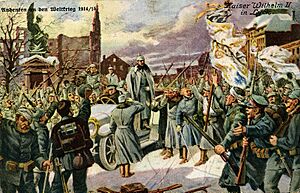
The "spirit of 1914" was a feeling of strong support for the war when it first began. This feeling was mostly among educated middle and upper-class people. In the Reichstag (German parliament), everyone voted to support the war, even the Social Democrats. Many people hoped for a quick victory.
However, this hope quickly disappeared as the invasion of Belgium got stuck and the French army held its ground. The Western Front became a deadly place where armies moved only a few yards at a time. By late 1914, industries were in chaos, and unemployment rose. It took months to change factories to produce weapons. In 1916, the Hindenburg Program called for all economic resources to be used to make artillery, shells, and machine guns. Even church bells and copper roofs were taken down and melted for the war effort.
Wartime Economy and Food Shortages
Germany had not planned how to use its civilian economy for the war, and it had no stored food or important supplies. Germany had to quickly figure things out. All major political groups supported the war at first.
Early in the war, industrialist Walter Rathenau helped set up the War Raw Materials Department. He was in charge of it and created the rules for how it worked. This department focused on raw materials that were hard to get because of the British blockade. It set prices and made sure important war industries got what they needed. It also started developing substitute materials.
While the War Raw Materials Department handled raw materials, the food crisis got worse. Many farmers and farm workers joined the military, and there were shortages of fertilizer. This steadily reduced the food supply. Prisoners of war were sent to work on farms, and many women and older men took on new jobs. Supplies that used to come from Russia and Austria were cut off.
During World War I, "total war" meant that food supplies had to go to the soldiers first. With German trade stopped by the British blockade, German civilians had to live with less and less. Food prices were controlled. Bread rationing started in 1915 and worked well, and the cost of bread went down. However, hundreds of thousands of civilians died from malnutrition or diseases their weakened bodies couldn't fight off. A study found that German children suffered from severe malnutrition during the blockade, especially working-class children. They recovered quickly after the war thanks to international food aid.
Conditions at home got worse quickly, with severe food shortages in all cities. This was because many farmers joined the military, the railroad system was overloaded, there was a lack of coal, and the British blockade stopped imports. The winter of 1916–1917 was called the "turnip winter." This was because potatoes were scarce, and people ate turnips, which were usually fed to animals. Thousands of soup kitchens opened to feed hungry people. Even the army had to cut soldiers' food rations. The morale of both civilians and soldiers continued to drop.
There was also a shortage of coal, which was the main energy source. Textile factories made army uniforms, so warm clothing for civilians became scarce. Using substitute materials like paper and cardboard for cloth and leather didn't work well. Soap and hot water were also in short supply. Cities reduced tram services, turned off streetlights, and closed theaters.
The food supply focused more and more on potatoes and bread. It became harder to buy meat. The meat ration in late 1916 was only 31% of what it was in peacetime, and it fell to 12% by late 1918. Fish rations were 51% in 1916 and completely gone by late 1917. Rations for cheese, butter, rice, cereals, eggs, and lard were less than 20% of peacetime levels. In 1917, the harvest was poor across Europe, and the potato supply ran low. Germans had to eat almost inedible turnips, and the "turnip winter" was remembered with bitterness for generations.
German women did not serve in the army, but many took paid jobs in factories. Even more volunteered for services. Housewives learned to cook without milk, eggs, or fat. Agencies helped widows find work. Banks, insurance companies, and government offices hired women for office jobs for the first time. Factories hired women for unskilled labor. By December 1917, half the workers in chemical, metal, and machine tool factories were women. Laws protecting women in the workplace were relaxed, and factories set up canteens to feed their workers. The food situation in 1918 was a bit better because of a better harvest, but serious shortages continued, with high prices, and no fresh fruit. Many people moved to cities for industrial jobs, leading to overcrowded housing. Reduced coal supplies meant everyone was cold. Daily life involved long working hours, poor health, little fun, and growing fears for loved ones in the army.
Defeat and Revolution
Many Germans wanted the war to end. More and more people started to support political groups like the Social Democratic Party and the more radical Independent Social Democratic Party, which demanded an end to the war. A big reason for Germany's defeat was the United States joining the war in April 1917. This shifted the balance of power even more towards the Allies.
At the end of October 1918, in Kiel, northern Germany, the German Revolution of 1918–19 began. Sailors refused to fight a final battle against the British Navy. Through groups called workers' and soldiers' councils, the revolt quickly spread across Germany. Meanwhile, Hindenburg and the top generals lost faith in the Kaiser and his government.
In November 1918, with revolution happening inside Germany, the war at a standstill, Bulgaria and the Ottoman Empire asking for peace, Austria-Hungary breaking apart, and pressure from the German High Command and the workers' and soldiers' councils, the Kaiser and all German royal families gave up their power. On November 9, 1918, the Social Democrat Philipp Scheidemann declared a Republic. The new government, led by the German Social Democrats, asked for and received an armistice (a ceasefire) on November 11, 1918. In reality, it was a surrender. The Allies kept up the food blockade to have an advantage in peace talks. The German Empire was replaced by the Weimar Republic.
Seven million soldiers and sailors were quickly sent home. Some joined right-wing groups like the Freikorps. Others, more radical, helped form the Communist Party of Germany.
Because German military forces were still in parts of France when the war ended, some nationalist groups and people angry about the defeat blamed civilians. They accused them of betraying the army and surrendering. This led to the "Stab-in-the-back myth" (the idea that the army was betrayed from within), which caused distrust of democracy and the new Weimar government in the 1920s.
War Deaths
Out of a population of 65 million, Germany lost 1.7 million soldiers and 430,000 civilians due to the war, mainly because of the food blockade. About 17,000 were also killed in Africa and the other overseas colonies.
The Allied blockade continued until July 1919, causing even more hardship for Germans.
Soldiers' Experiences
Even though the German military machine was often harsh, individual German soldiers could respect and feel for the enemy. They often felt contempt for the war itself. Here are some examples from letters they sent home:
"A terrible picture presented itself to me. A French and a General soldier on their knees were leaning against each other. They had pierced each other with the bayonet and had dropped like this to the ground...Courage, heroism, does it really exist? I am about to doubt it, since I haven't seen anything else than fear, anxiety , and despair in every face during the battle. There was nothing at all like courage, bravery, or the like. In reality, there is nothing else than texting discipline and coercion propelling the soldiers forward" Dominik Richert, 1914.
"Our men have reached an agreement with the French to cease fire. They bring us bread, wine, sardines etc., we bring them schnapps. The masters make war, they have a quarrel, and the workers, the little men...have to stand there fighting against each other. Is that not a great stupidity?...If this were to be decided according to the number of votes, we would have been long home by now" Hermann Baur, 1915.
"I have no idea what we are still fighting for anyway, maybe because the newspapers portray everything about the war in a false light which has nothing to do with the reality.....There could be no greater misery in the enemy country and at home. The people who still support the war haven't got a clue about anything...If I stay alive, I will make these things public...We all want peace...What is the point of conquering half of the world, when we have to sacrifice all our strength?..You out there, just champion peace! … We give away all our worldly possessions and even our freedom. Our only goal is to be with our wife and children again," Anonymous Bavarian soldier, 17 October 1914.
See also
- German entry into World War I
- History of Germany
- History of German foreign policy
- Home front during World War I
- International relations of the Great Powers (1814–1919)
- Central Powers


